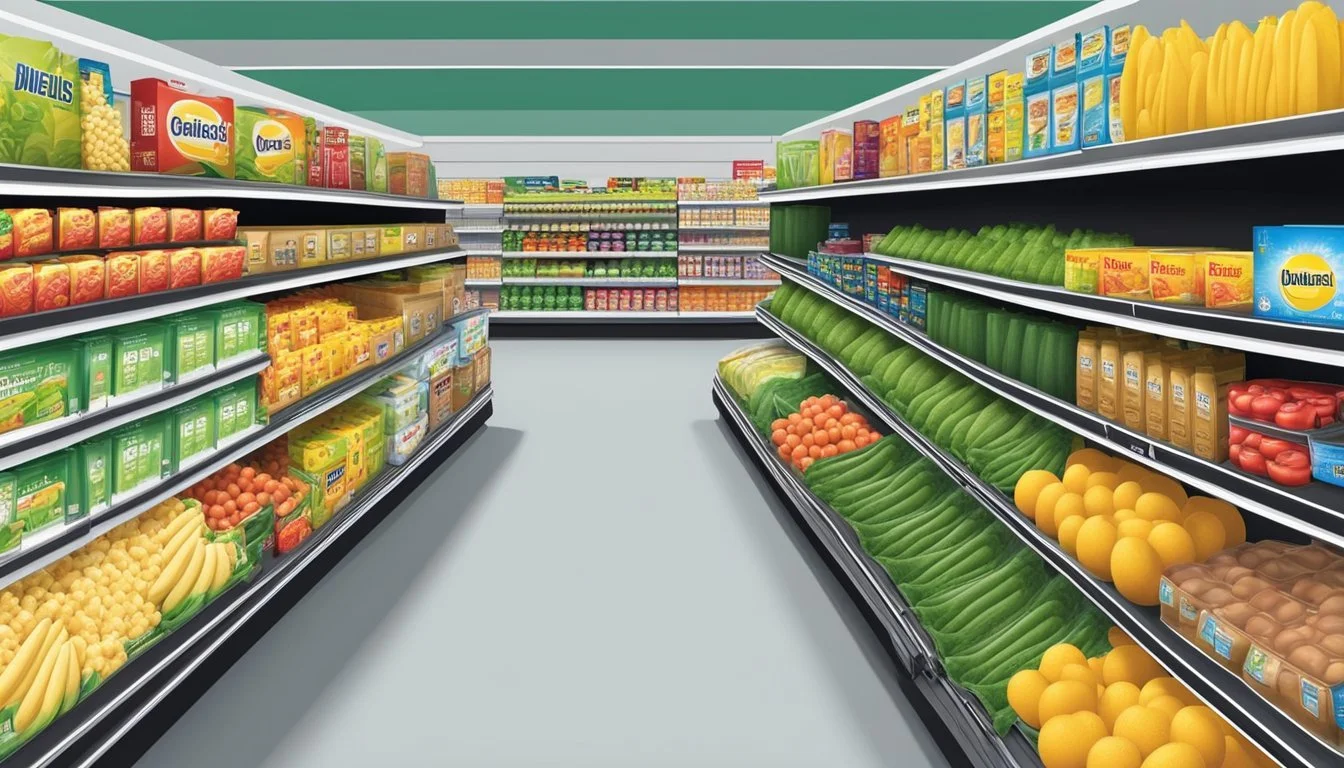Dollar General vs Meijer
A Comprehensive Comparison of Price and Quality
Dollar General and Meijer are two popular grocery chains that offer different shopping experiences and value propositions. Both stores aim to provide affordable options for customers, but they differ in their product selection, pricing strategies, and overall shopping environment.
While Walmart often leads in overall pricing, Meijer tends to offer better value on certain beverages and dry goods compared to Dollar General. This price difference can result in significant savings for frequent shoppers. For example, a family spending $250 weekly on groceries could potentially save over $1,400 annually by choosing the more cost-effective option.
Beyond pricing, other factors like product quality, store layout, and customer service play crucial roles in determining which store provides a better overall shopping experience. Examining these aspects can help shoppers make informed decisions about where to spend their grocery dollars.
Brand Overviews
Dollar General and Meijer have distinct histories, business models, and market positions in the retail grocery industry. Both companies have experienced significant growth and maintain strong regional presences.
History and Growth
Dollar General was founded in 1939 in Scottsville, Kentucky. The company initially focused on selling household goods at discounted prices. Over the decades, Dollar General expanded rapidly, particularly in rural areas and small towns across the United States.
Meijer, on the other hand, started as a small grocery store in Greenville, Michigan in 1934. The company pioneered the supercenter concept, combining groceries with general merchandise. Meijer's growth has been concentrated in the Midwest region.
Business Models and Operations
Dollar General operates small-format stores, typically around 7,400 square feet. These stores offer a limited selection of groceries, household items, and personal care products at low prices. The company targets budget-conscious shoppers in underserved markets.
Meijer runs large supercenters, averaging 150,000-250,000 square feet. These stores provide a wide array of groceries, fresh produce, and general merchandise. Meijer caters to a broader customer base, offering both value and premium products.
Market Share and Revenue
Dollar General has a larger national footprint with over 17,000 stores across 46 states. The company's revenue reached $33.7 billion in 2020, reflecting its strong market position in the discount retail sector.
Meijer operates approximately 250 stores in six Midwest states. While privately owned, estimates suggest Meijer's annual revenue exceeds $17 billion. The company holds a significant market share in its core Midwest markets, competing effectively with national chains.
Both retailers continue to expand, with Dollar General focusing on new store openings and Meijer investing in store remodels and e-commerce capabilities.
Store Offerings
Dollar General and Meijer offer distinct product selections to cater to different shopping needs. Their offerings vary in range, quality, and brand options.
Product Range and Varieties
Dollar General focuses on providing everyday essentials at affordable prices. The store stocks a limited selection of groceries, household items, and personal care products. Their food offerings typically include shelf-stable goods, snacks, and basic refrigerated items.
Meijer, in contrast, operates as a supercenter with a vast array of products. The store offers a full-service grocery department, including fresh produce, meat, seafood, and dairy. Meijer also carries clothing, electronics, home goods, and even garden supplies.
Quality of Goods
Dollar General's products are generally of acceptable quality for their price point. The store aims to provide budget-friendly options, which may result in some items being of lower quality compared to premium alternatives.
Meijer emphasizes quality across its product lines. The store's fresh produce department is known for its high standards. Meijer's meat and seafood sections offer a range of choices, from budget-friendly options to premium cuts.
Private Label vs. National Brands
Dollar General stocks a mix of national brands and its own private label products. The store's private labels, such as Clover Valley and DG Home, offer cheaper alternatives to name-brand items.
Meijer carries a wide selection of national brands alongside its own private label offerings. The store's private brands, including Meijer and True Goodness, span various product categories and often provide a balance of quality and affordability.
Organic and Farm-Fresh Selection
Dollar General's organic and farm-fresh options are limited. The store may carry some organic packaged goods, but fresh organic produce is typically not available.
Meijer boasts a robust organic and farm-fresh selection. The store's produce department features a variety of organic fruits and vegetables. Meijer also offers organic options in other categories, such as dairy, meat, and packaged goods. The store often partners with local farmers to provide fresh, seasonal produce.
Pricing Strategies
Dollar General and Meijer employ distinct pricing approaches to attract and retain customers. Their strategies encompass everyday pricing, discounts, promotions, and loyalty programs.
Everyday Pricing and Discounts
Dollar General focuses on offering consistently low prices across its product range. Most items are priced under $10, with discounts of 20% to 40% compared to full-price retailers. This approach allows customers to find affordable options for everyday essentials.
Meijer, on the other hand, maintains competitive pricing on a wider variety of products. They offer a mix of national brands and their own private label items at various price points. Meijer's pricing strategy aims to provide value across different product categories and quality levels.
Both stores use price matching policies to stay competitive. Dollar General often adjusts prices based on local competitors, while Meijer matches prices from specific retailers in their operating areas.
Comparison of Cost Efficiency
Dollar General's no-frills store layout and limited product assortment contribute to its cost efficiency. The company operates with minimal staff and focuses on fast-moving items, reducing overhead costs.
Meijer's larger store format allows for a broader product selection but may result in higher operational costs. However, their scale and distribution network help offset some expenses.
In terms of produce, Meijer offers a wider variety, including organic options. This selection may come at a higher price point compared to Dollar General's more limited fresh produce offerings.
For a typical grocery basket, Meijer tends to be priced slightly higher than discounters like Walmart but often lower than traditional supermarkets.
Sales and Promotions
Dollar General runs weekly specials and digital coupons accessible through their app. These promotions often focus on household staples and seasonal items.
Meijer offers a robust weekly ad with numerous sale items across departments. They frequently use mix-and-match promotions, allowing customers to save more when purchasing multiple items.
Both stores leverage holiday and seasonal sales to drive traffic. Dollar General emphasizes value-oriented holiday decor and gifts, while Meijer provides a broader range of seasonal offerings at various price points.
Flash sales and clearance events are common at both retailers, with Dollar General often featuring $1 deals on select items.
Loyalty Programs and Rewards
Meijer's mPerks program stands out as a comprehensive loyalty system. It offers personalized rewards, digital coupons, and points that can be redeemed for discounts on future purchases.
Members receive tailored offers based on their shopping habits and can stack rewards with manufacturer coupons for additional savings. The program also includes pharmacy rewards and fuel discounts at Meijer gas stations.
Dollar General's loyalty offering is more limited. Their DG Digital Coupons program allows customers to clip digital coupons for use at checkout. While not as extensive as mPerks, it provides an easy way for shoppers to access additional discounts.
Both programs are free to join and can be accessed through mobile apps, making it convenient for customers to save money on their purchases.
Shopping Experience
Dollar General and Meijer offer distinct shopping experiences that cater to different customer needs. Their store layouts, customer service approaches, checkout processes, and product availability shape how shoppers interact with each retailer.
Store Layout and Design
Dollar General stores are typically smaller, with a straightforward layout designed for quick trips. Aisles are narrow but organized by product category. Signage is clear, making it easy to find basic household items and groceries.
Meijer stores are much larger, often operating as supercenters. They feature wide aisles and clearly defined departments. The spacious layout allows for a more relaxed shopping experience. Meijer stores often include specialty sections like electronics, clothing, and garden centers.
Customer Service
Dollar General emphasizes efficiency over personalized service. Staff members are trained to keep shelves stocked and checkout lines moving. While employees are generally helpful, the focus is on maintaining a streamlined shopping experience.
Meijer places a stronger emphasis on customer service. Staff members are usually more readily available throughout the store to assist shoppers. Many Meijer locations offer specialized services like pharmacy consultations and electronics support.
Checkout Efficiency
Dollar General prioritizes quick transactions. Stores often have limited checkout lanes but focus on moving customers through rapidly. Self-checkout options are becoming more common in newer or renovated locations.
Meijer typically offers more checkout lanes, including express lanes for small purchases. Many stores feature both staffed and self-checkout options. During peak hours, Meijer may open additional lanes to manage higher customer volumes.
In-Store Availability
Dollar General stocks a curated selection of everyday essentials. While the variety is limited, popular items are usually well-stocked. The focus is on providing basic necessities and household goods at competitive prices.
Meijer offers a much wider product range, including fresh produce, meats, and bakery items. The larger store format allows for greater variety in each product category. Seasonal items and local products are often featured prominently.
Community and Environmental Impact
Dollar General and Meijer have distinct approaches to community engagement and environmental stewardship. Their initiatives in local sourcing, partnerships, and sustainability efforts impact both their local communities and the broader environment.
Local Sourcing and Partnerships
Dollar General focuses on providing affordable products to underserved communities. The company partners with local organizations to support literacy programs and offer job opportunities. However, their local sourcing efforts are limited.
Meijer, on the other hand, emphasizes stronger ties with local producers. The retailer collaborates with regional farms to stock fresh, locally-grown produce. This practice supports local economies and reduces transportation emissions. Meijer also hosts farmers markets in store parking lots, giving small-scale farmers direct access to customers.
Sustainability Initiatives
Dollar General's sustainability efforts are less prominent. The company has implemented some energy-efficient practices in stores but lacks comprehensive environmental programs.
Meijer demonstrates a more robust commitment to sustainability. The retailer aims to reduce food waste by 50% per store by 2030. They've implemented recycling programs and energy-efficient technologies in their operations. Meijer also offers a wider selection of organic produce and products, catering to environmentally-conscious consumers.
Both companies contribute to their communities, but Meijer's initiatives appear more extensive in terms of local partnerships and environmental impact.
Regional Presence and Accessibility
Dollar General and Meijer have distinct approaches to store locations and market reach. Their strategies impact accessibility for customers across different regions and community types.
Location Strategy
Dollar General focuses on widespread coverage, with over 18,000 stores across 47 states. The company targets small towns and rural areas, often placing stores in communities with populations under 20,000. This approach allows Dollar General to serve areas that larger retailers may overlook.
Meijer operates primarily in the Midwest, with around 250 stores concentrated in Michigan, Ohio, Indiana, Illinois, Kentucky, and Wisconsin. The company emphasizes larger format stores in suburban and urban areas, typically ranging from 150,000 to 250,000 square feet.
Urban vs. Rural Reach
Dollar General excels in rural accessibility. Its small-format stores (around 7,400 square feet) fit well in less populated areas. The company aims to be within a 5-10 minute drive for most rural customers, filling gaps in food deserts.
Meijer targets more densely populated regions with its supercenter model. These stores offer a wider product range but require larger populations to support them. Meijer's urban and suburban focus provides extensive options for city and town dwellers but limits its presence in rural America.
Comparison with Competitors
Dollar General and Meijer face stiff competition in the grocery and discount retail space. Both chains have unique strengths and weaknesses compared to their rivals.
Competitive Analysis
Dollar General competes directly with other discount retailers like Family Dollar and Dollar Tree. It offers lower prices on many items compared to traditional grocers. However, its product selection is more limited.
Meijer faces competition from major supermarket chains and big-box retailers. Its main rivals include Walmart, Kroger, and Target. Meijer offers a wider selection than Dollar General, especially in fresh produce and perishables.
Walmart tends to have the lowest overall prices among major chains. A typical basket of groceries costs about 13% less at Walmart compared to average prices at other stores. Meijer's prices are about 11% below average, making it competitive but slightly pricier than Walmart.
Similarities and Differences
Dollar General and Meijer both aim to offer value, but through different approaches. Dollar General focuses on small-format stores in rural and urban areas. It stocks a limited assortment of everyday essentials at low prices.
Meijer operates large supercenters similar to Walmart. It carries a full line of groceries plus general merchandise. Meijer's produce departments resemble farmers markets with wide selections of fruits and vegetables.
Unlike Dollar General, Meijer sources more products from local farms. It also offers a larger organic selection. However, Dollar General's smaller stores may be more convenient for quick trips.
Both chains lag behind Aldi and Costco in terms of rock-bottom prices. But they offer more familiar brands and shopping experiences than those no-frills retailers.







